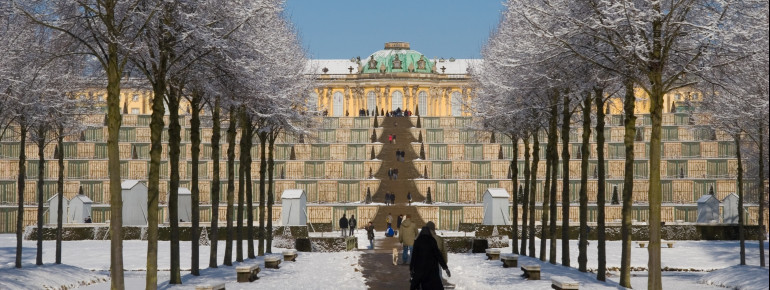Contents
Description

Sanssouci Palace with its 290ha park area is the oldest part of the Potsdam cultural landscape that has flourished over a period of four centuries and was created by numerous artists. The palace is a listed UNESCO World Heritage Site and regularly offers interesting exhibitions about the Potsdam cultural landscape as well as the history of Prussia. It attracts more than 1 million visitors each year.
A Place of No Worries
Sanssouci was built at Frederick the Great's wishes, and is one of the most famous Hohenzollern palace. The name still says it all: just as the Prussian king had intended, it is easy to let go of your worries once you're walking through the palace and its extensive park. South of the palace you can find Charlotte's Court, the rosery, the Poets' Grove, and the former carp pond. The typical rococo-style ornaments, stucco ceilings, and elegant furnishing make the palace a work of art.
Highlights at the Palace
In bygone times, concerts used to take place at the music room, contribuiting to the palace's fame. Nowadays you can marvel at the pianoforte Johann Sebastian Bach's son used to play, along with instruments that belonged to the very musical King Frederick II. Another highlight is the marble room. Marble-linded walls and floors are reminiscent of the ancient world. The picture gallery is located in the eastern part of the palace, and is solely dedicated to paintings. It is the oldest remaining auntonomous museum building in Germany. It features artwork from Italian Renaissance as well as Flemish and Italian Baroque.
Historical Information

Originally, the Prussian king wished to grow figs, wine and plums on the outskirts of Potsdam. This is why he decided to have a terrace garden created in the park of Sanssouci in 1744. The view from the park was so much to his liking that he decided to have a maison de plaisance built there in his name. The Rococo style summer palace was built under the supervision of Georg Wenzeslaus von Knobelsdorff according to the sketches of Frederick in the period between 1745 and 1747. Within a short period, the Sanssouci Palace became his favourite place of retreat. The green slopes were henceforth used as vegetable and ornamental gardens.
Over the years, the picture gallery, a separate building to store his collection of paintings, as well as the new palais. Frederick William IV's widow was the last inhabitant of the palace. After her, it was turned into a museum and opened its doors to the public in April 1927. Frederick the Great's wish to be buried at Sanssouci only came true in 1991, when his body was transferred to the terrace on the vineyard.
Interesting facts
- Palais Sanssouci Potsdam is among the 3 best rated Tourist Attractions in Brandenburg.
How to get there
Sanssouci Palace is comfortably reached by public transport.
By S-Bahn (city train): From Potsdamer Platz Bahnhof (Berlin) (S+U): S1, S2, S25
By subway: From Potsdamer Platz Bahnhof (Berlin) (U): U2
By bus:
- From Varian-Fry-Str. (Berlin): 200, N2, M48, M85
- From Potsdamer Platz Bhf/Voßstr. (Berlin) (S): M41, M85
- From Potsdamer Platz Bhf (Berlin) (S+U): M41, M48
- From Abgeordnetenhaus (Berlin): M41
- From Philharmonie (Berlin): 200, M41
- From Kulturforum (Berlin): N2, M48, M85
- From Potsdamer Brücke (Berlin): N1, N2, M29, M48, M85













